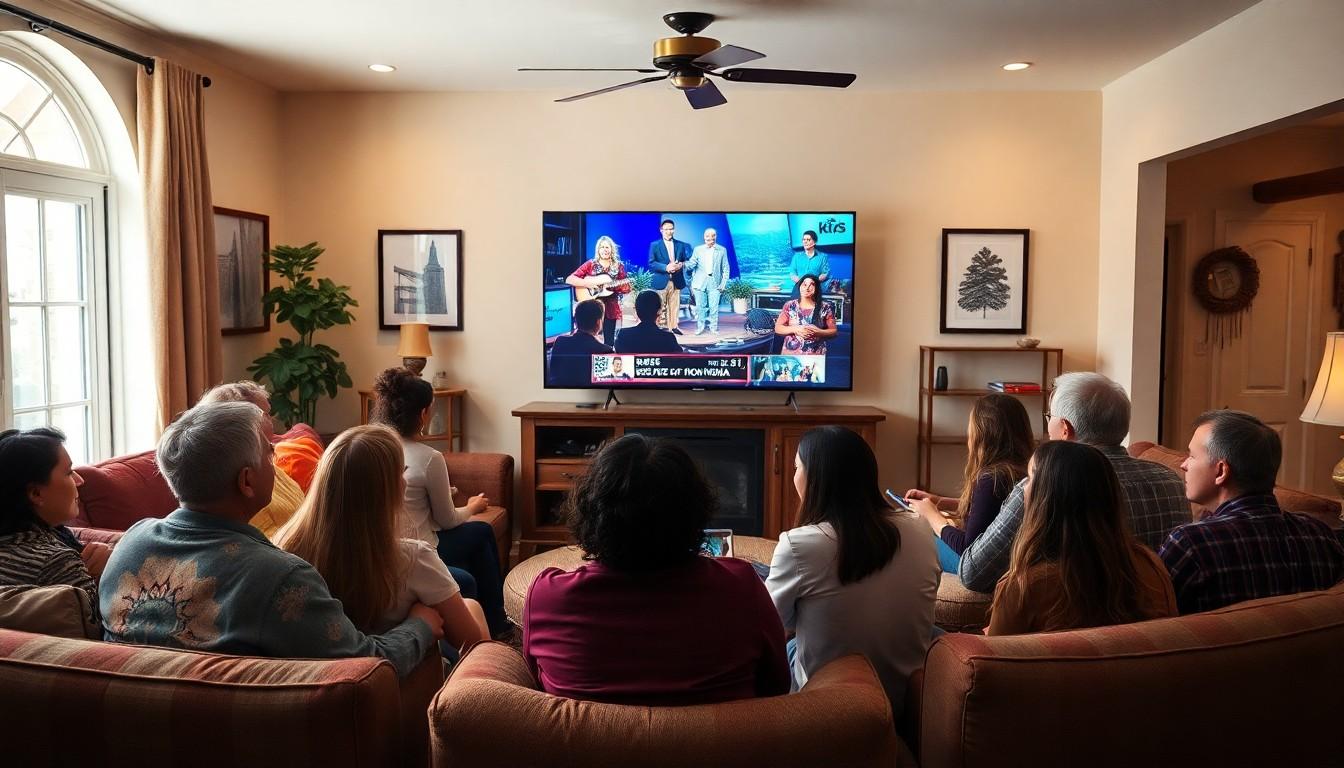In a world overflowing with content, broadcast media stands out like a neon sign in a dark alley. It’s the powerhouse behind TV shows, radio stations, and even those catchy jingles that get stuck in your head. But what exactly is broadcast media? It’s more than just a way to pass the time; it’s a vital tool for communication that connects millions, influences opinions, and shapes culture.
Broadcast Media Definition
Broadcast media serves as a key communication platform, encompassing television and radio broadcasts meant for wide audience reach. It connects people by delivering news, entertainment, and educational content across vast distances.
Historical Context
Broadcast media’s origins trace back to the early 20th century with the advent of radio. The first radio transmission occurred in 1906, marking the birth of mass communication. Television followed in the 1920s, revolutionizing how audiences consume content. Throughout the decades, both mediums evolved, with innovations like color TV in the 1950s and satellite radio in the 1990s expanding their reach further. The rise of cable and digital broadcasting in the late 20th century significantly increased channel options, enhancing viewer engagement.
Types of Broadcast Media
Several types of broadcast media exist, catering to diverse audiences. Television includes terrestrial, cable, and satellite formats, delivering varied programming. Radio offers AM, FM, and digital options, providing music, talk shows, and news. Podcasts represent new audio content delivery, gaining popularity in recent years. Webcasting and streaming services also fall under broadcast media, offering on-demand access to content. Online platforms enhance reach, enabling global audiences to engage with programming across different devices.
Key Characteristics of Broadcast Media

Broadcast media exhibits several defining characteristics that contribute to its effectiveness. Accessibility and public engagement stand out as critical elements influencing audience interaction and experience.
Accessibility
Accessibility represents a core feature of broadcast media. Audiences can access content via various platforms, including TV, radio, and online streaming services. These platforms often require minimal resources, such as a simple antenna or internet connection, providing broad access to a diverse range of demographics. Technological advancements, such as mobile apps, increase accessibility by allowing users to consume content on multiple devices. Additionally, broadcast media caters to individuals with different preferences by offering various formats, including news, entertainment, and educational programs.
Public Engagement
Public engagement drives the success of broadcast media initiatives. Through interactive components, like viewer polls and social media discussions, audiences can connect with content and creators. Broadcasting aims to inform, entertain, and provoke thought, fostering community dialogue that shapes public opinion. Live events and broadcasts further enhance audience participation, encouraging instant reactions and responses. Engaged audiences often feel a sense of ownership over the content, enhancing loyalty to the media brand.
Importance of Broadcast Media
Broadcast media plays a vital role in shaping societal discourse and keeping communities informed. Its broad reach and accessibility make it a powerful tool for communication.
Influence on Public Opinion
Broadcast media significantly shapes public opinion. By presenting diverse perspectives on current events, it guides audience perceptions. Viewers often rely on news programs for insights into political, social, and cultural issues. Polls indicate that over 60% of people trust television as their primary news source. Engaging content fosters discussions across social media platforms, leading to more informed citizenry. Additionally, influential broadcasters can sway opinions through effective storytelling, highlighting key issues and sparking public interest. This influence highlights the responsibility of broadcasters to ensure accuracy and impartiality.
Role in Information Dissemination
Information dissemination is a fundamental function of broadcast media. Timeliness differentiates it from other media types; breaking news can reach millions within seconds. Broadcast platforms cater to varied audiences, providing targeted content for different demographics. Events like natural disasters or political elections showcase broadcast media’s effectiveness in delivering urgent information. Research shows that about 80% of individuals learn about significant news events through television or radio. Educational programming further enriches public knowledge, ensuring communities stay informed and engaged. Enhanced availability through digital platforms continues to broaden access, facilitating immediate learning opportunities.
Challenges Facing Broadcast Media
Broadcast media faces numerous obstacles that hinder its effectiveness and reach. Key challenges include technological advancements and evolving regulatory frameworks.
Changing Technology

Technology evolves rapidly, affecting how audiences consume media. Streaming services provide on-demand content, drawing viewers away from traditional broadcasts. Mobile devices enable easy access to media anytime, anywhere, which alters audience expectations. Consequently, networks must adapt content to fit shorter attention spans and enhance interactivity. Data from 2023 shows that 80% of consumers prefer streaming platforms over conventional TV. Gaps in technology integration can lead to significant declines in viewership as audiences seek more personalized experiences.
Regulatory Issues
Regulatory challenges also create hurdles for broadcast media. Increased scrutiny over content accuracy demands strict compliance with established guidelines. Advertising regulations impact revenue streams, forcing broadcasters to navigate complex legal landscapes. The Federal Communications Commission (FCC) governs these standards, ensuring fairness and privacy in broadcasting. Non-compliance can result in fines or loss of broadcasting licenses. As public trust in media fluctuates, maintaining credibility amidst stricter regulations remains critical for broadcasters to thrive.
Broadcast media remains a vital force in shaping public discourse and connecting communities. Its ability to deliver diverse content across various platforms ensures that audiences stay informed and engaged. As technology continues to evolve, broadcast media must adapt to meet changing preferences while maintaining its commitment to accuracy and impartiality. The challenges ahead call for innovation and responsiveness, but the enduring relevance of broadcast media in today’s information landscape is undeniable. By embracing these changes, broadcasters can continue to play an essential role in influencing public opinion and enriching societal conversations.
